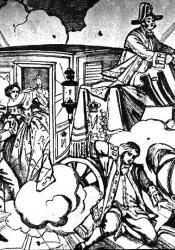Failed Assassination Attempt Leads to the Construction of the Palais Garnier
On January 14th, 1858, Napoleon III (President of France) and his wife rode by carriage to a show at the rue Le Peletier, a popular Paris Opera venue. As they arrived and attempted to step out, bombs were thrown with the attempt of killing the President. The assassin was Felice Orsini, an Italian nationalist revolutionary, who wished to incite a revolution in France that would spread to Italy. His attempt failed, as the King and wife were uninjured but several others were killed. Orsini was arrested and sentenced to death, but his actions did lead to Napoleon III declaring war on Austria in 1859, leading to Italy’s independence. After such a close encounter to death, the President was troubled by his lack of safety during times of enjoyment. This inspired the idea for the construction of a new opera house-- one with a separate and secure entrance for him. From this arose the Palais Garnier, a widely known ballet and opera house owned by the Paris Opera Company. Highly decorated with elaborate marble carvings and medallions stamped “N” for Napoleon III, this building was designed with the rich, high class members of Paris as priority. The performance stage was designed at an angle to allow all spectators a proper view, and “subscribers” who paid a regular fee were granted exclusive access behind the stage in an area known as the foyer de la danse. This area became known for exploitation among the performing women and girls in training, as they could not make a livable wage from the Paris Opera Company and many times were financially responsible for their family. In return for sexual favors, the girls would receive money, private lessons, a home to live in, among other things. Many times this was bound in contract, the contracts even written and agreed upon between the “patron” and the girl’s own mother. Despite the prestige and grace held for the art of ballet, the ballerinas themselves were seen by society as simply well-dressed prostitutes, whether they had accepted the advances of wealthy men or not.
“Felice Orsini.” Encyclopædia Britannica, Encyclopædia Britannica, Inc.,https://www.britannica.com/biography/Felice-Orsini.
Pierre. “Palais Garnier - Explore Paris' Prestigious Opera House.” French Moments, 28 Feb. 2020, https://frenchmoments.eu/palais-garnier-paris/.

